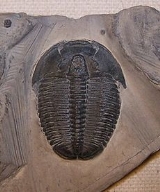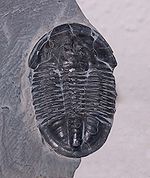
Ptychopariida
Encyclopedia
Ptychopariida is a large, heterogeneous order of trilobite
containing some of the most primitive species known. Many date to the Early Cambrian
Period, but the order was extant through the Late Ordovician
. Many of the offshoot species are difficult to classify in this single order.
 Trilobites have facial sutures that run along the margin of the glabella
Trilobites have facial sutures that run along the margin of the glabella
and/or fixigena to the shoulder point where the cephalon meets the thorax. These sutures outline the cranidium, or the main, central part of the head that does not include the librigena (free cheeks). The eyes are medial along the glabella on the suture line (however, some species have no eyes). The fossil
s of the moults
of trilobites can often be told from the fossils of the actual animals by whether or not the librigena are present. (The librigena are no longer attached in moults.) In Ptychopariida, short bladelike genal spines are often present on the tips of the librigena.
The thorax is large and is typically made up of eight or more segments. The thorax is usually much longer than the pygidium
, which is usually small. In some species the pygidium is outlined with a flat border.
The Subclass Librostoma was recently created to encompass several related orders: Ptychopariida, Asaphida
, Proetida
, Harpetida
, and possibly the Phacopida
. These are now known as the "Librostome Orders". The Proetida and Harpetida were originally included in Order Ptychopariida.
Trilobite
Trilobites are a well-known fossil group of extinct marine arthropods that form the class Trilobita. The first appearance of trilobites in the fossil record defines the base of the Atdabanian stage of the Early Cambrian period , and they flourished throughout the lower Paleozoic era before...
containing some of the most primitive species known. Many date to the Early Cambrian
Cambrian
The Cambrian is the first geological period of the Paleozoic Era, lasting from Mya ; it is succeeded by the Ordovician. Its subdivisions, and indeed its base, are somewhat in flux. The period was established by Adam Sedgwick, who named it after Cambria, the Latin name for Wales, where Britain's...
Period, but the order was extant through the Late Ordovician
Ordovician
The Ordovician is a geologic period and system, the second of six of the Paleozoic Era, and covers the time between 488.3±1.7 to 443.7±1.5 million years ago . It follows the Cambrian Period and is followed by the Silurian Period...
. Many of the offshoot species are difficult to classify in this single order.

Glabella
The glabella, in humans, is the space between the eyebrows and above the nose. It is slightly elevated, and joins the two superciliary ridges.-Etymology:The term is derived from the Latin glabellus, meaning smooth, as this area is usually hairless....
and/or fixigena to the shoulder point where the cephalon meets the thorax. These sutures outline the cranidium, or the main, central part of the head that does not include the librigena (free cheeks). The eyes are medial along the glabella on the suture line (however, some species have no eyes). The fossil
Fossil
Fossils are the preserved remains or traces of animals , plants, and other organisms from the remote past...
s of the moults
Ecdysis
Ecdysis is the moulting of the cuticula in many invertebrates. This process of moulting is the defining feature of the clade Ecdysozoa, comprising the arthropods, nematodes, velvet worms, horsehair worms, rotifers, tardigrades and Cephalorhyncha...
of trilobites can often be told from the fossils of the actual animals by whether or not the librigena are present. (The librigena are no longer attached in moults.) In Ptychopariida, short bladelike genal spines are often present on the tips of the librigena.
The thorax is large and is typically made up of eight or more segments. The thorax is usually much longer than the pygidium
Pygidium
The pygidium is the posterior body part or shield of crustaceans and some other arthropods, such as insects and the extinct trilobites. It contains the anus and, in females, the ovipositor...
, which is usually small. In some species the pygidium is outlined with a flat border.
The Subclass Librostoma was recently created to encompass several related orders: Ptychopariida, Asaphida
Asaphida
Asaphida is a large, morphologically diverse order of trilobite found in strata dated from the Middle Cambrian to the Silurian. The order contains six superfamilies , but no suborders...
, Proetida
Proetida
Proetida is an order of trilobite that lived from the Ordovician to the Permian. It was the last order of trilobite to go extinct, finally dying out in the Permian extinction....
, Harpetida
Harpetida
Harpetida is one of the nine orders of the extinct arthropod class Trilobita. They lived from the Upper Cambrian to the Late Devonian period....
, and possibly the Phacopida
Phacopida
Phacopida is an order of trilobite that lived from the Ordovician to the Devonian. It is made up of a morphologically diverse group of related suborders....
. These are now known as the "Librostome Orders". The Proetida and Harpetida were originally included in Order Ptychopariida.

